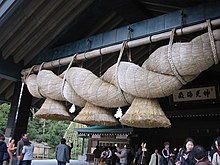
Back شيمناوا Arabic Shimenawa Catalan Šimenawa Czech Shimenawa German Σιμενάουα Greek Shimenawa Spanish شیمهناوا Persian Shimenawa Finnish Shimenawa French Shimenawa ID
| Shimenawa | |
|---|---|
| しめ縄 | |
 | |
| Material | Hemp fiber/Straw |
| Present location | Japan |
| Culture | Shinto |
Shimenawa (標縄/注連縄/七五三縄, lit. 'enclosing rope') are lengths of laid rice straw or hemp[1] rope used for ritual purification in the Shinto religion.
Shimenawa vary in diameter from a few centimetres to several metres, and are often seen festooned with shide—traditional paper streamers. A space bound by shimenawa typically indicates a sacred or ritually pure space, such as that of a Shinto shrine.[2] Shimenawa are believed to act as a ward against evil spirits, and are often set up at a ground-breaking ceremony before construction begins on a new building. They are often found at Shinto shrines, torii gates, and sacred landmarks.
Shimenawa are also placed on yorishiro, objects considered to attract spirits or be inhabited by them. These notably include being placed on certain trees, the spirits considered to inhabit them being known as kodama. Cutting down these trees is thought to bring misfortune. In the case of stones considered to be inhabited by spirits, the stones are known as iwakura (磐座/岩座).[3]
A variation of the shimenawa are worn in sumo wrestling by yokozuna (grand champions), during the entrance ceremony to debut as grand champion rank. In this instance, shimenawa used by yokozuna are seen as being living yorishiro (a vessel capable of housing a spirit, known as shintai when inhabited by a spirit), and are therefore visually distinguished as "sacred".
- ^ "Mie gov't rejects cannabis cultivation request for Shinto rituals". Japan Today. Archived from the original on 2017-01-09.
- ^ Cf. Kasulis (2004:17-23).
- ^ "Shimenawa & Rock", More glimpses of unfamiliar Japan, Thursday, March 18, 2010